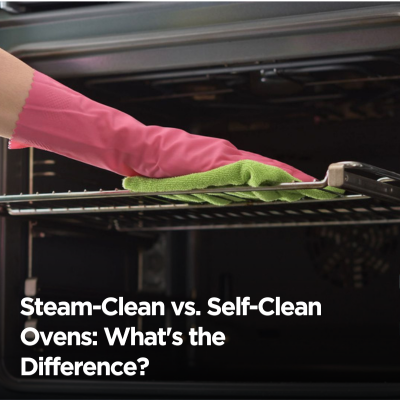Ovens are the most crucial aspect of every contemporary commercial kitchen and entirely change how we cook food. The commercial ovens industry is expected to outgrow by over $22 Billion by 2033. However, the quality of food ovens produce is significantly influenced by their maintenance and cleaning.
Oven cleaning is crucial in maintaining kitchen efficiency, food safety, and appliance longevity. A dirty oven can lead to uneven cooking, unpleasant odors, and even potential fire hazards. Unlike other food and beverage service equipment, they are often overlooked because most oven cleaning methods require the oven to be completely cool. It’s easy to notice buildup while cooking, only to forget it once the oven is off.
While most people in the catering industry or households recognize the importance of cleaning their ovens, finding the right way can be challenging. Confusion arises when choosing steam-clean vs. self-clean ovens.
This blog post will help you discover the differences between steam-cleaning ovens vs. self-cleaning ovens to assist both home cooks and professionals choose the best method for keeping their ovens in the cleanest, best working condition while maintaining high standards in their kitchens.
Why Oven Cleaning is Important
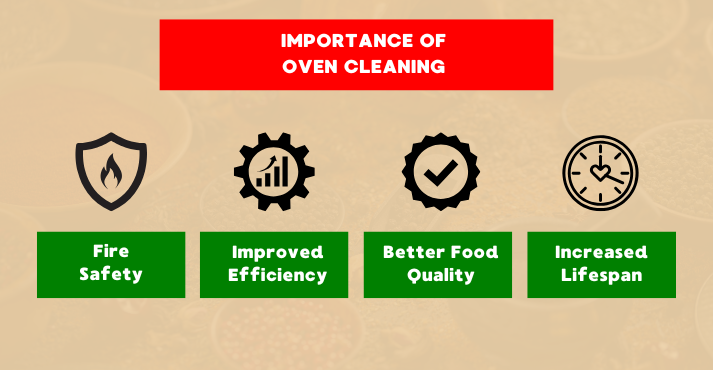
Regular oven maintenance is a critical aspect of adequate handling of kitchenware for restaurant owners, hotel managers, and culinary professionals. Let’s discover why it is necessary to ensure your oven is properly cleaned and maintained for reliable and safe handling.
Fire Safety
A dirty oven with built-up grease, food debris, and spills poses a serious fire risk. When food remnants or oil splatters come into contact with high temperatures, they can start burning, releasing smoke and fumes.
All these factors create an unpleasant cooking environment and increase the chances of an oven fire. Regularly Cleaning your oven or wiping spills when it cools down helps prevent fire hazards.
Improved Efficiency
A poorly maintained and dirty oven undergoes slowed-down heating and uneven heat distribution. It causes a significant increase in cooking time and energy consumption.
If grime and grease cover the heating elements and conductive surface, the oven must work harder to reach the desired temperature with prolonged cooking durations, leading to higher energy bills.
Another aspect is a dirty oven door that prevents visibility, forcing users to open it frequently to check food. Heat escapes every time the door opens, lowering the temperature and affecting cooking efficiency.
Better Food Quality
If left unmaintained, your kitchen technology starts suffering and producing poorly cooked food. The same applies to the oven, the main character in your kitchen story. Leftover food particles and grease can create unpleasant odors and contaminate fresh meals.
This is especially noticeable when baking desserts after cooking strong-smelling foods like roasts or curries. Grease buildup can also cause smoke, altering the desired food taste.
A clean oven eliminates these issues and ensures every meal retains its intended flavor without unwanted residues from previous dishes.
Increased Appliance Lifespan
A neglected oven has to work harder to maintain the correct temperature, leading to faster wear and tear. Grease and carbon deposits can clog vents and damage heating elements. This causes a significant decrease in the oven’s performance over time.
Regular cleaning prevents buildup, ensuring smooth operation and extending the appliance’s lifespan, saving you money on repairs or early replacement.
What is a Steam-Clean Oven?
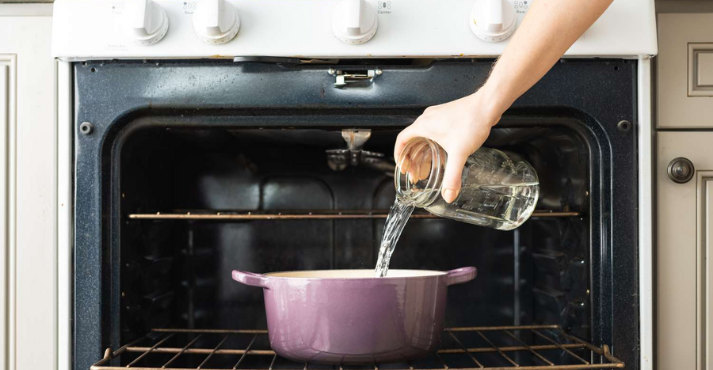
A steam-clean oven is designed to simplify the cleaning process by using steam to loosen the grip of food residue, grease, and grime on oven vents and surfaces.
Unlike traditional self-cleaning ovens that rely on extreme heat (pyrolytic cleaning), steam-clean ovens operate at a much lower temperature, making the process quicker and more energy-efficient.
How Does a Steam-Clean Oven Work?
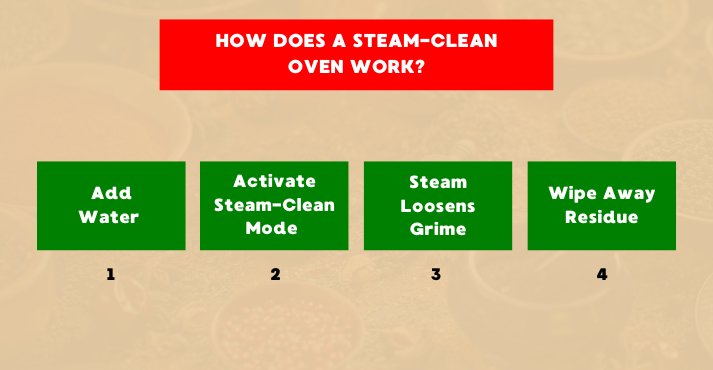
The steam-clean function introduces moisture into the oven chamber, which helps break down stubborn buildup.
Here’s how you can begin steam cleaning:
- Add Water – Pour a small amount of clean water (usually about a cup) into the bottom of the oven or the designated steam-clean reservoir.
- Activate Steam-Clean Mode – Select the steam-clean function on the oven’s control panel. The oven will begin heating at a low temperature (typically around 250°F or 120°C).
- Steam Loosens Grime – As the water heats up, it becomes steam, softening food particles, grease, and stains on the oven’s walls and floor (Usually takes around 20–30 minutes).
- Wipe Away Residue – Once the cycle is complete and the oven has completely cooled down, use a damp cloth or sponge to wipe away the loosened grime.
Benefits of a Steam-Clean Oven
The differentiating factor between steam cleaning and self-cleaning ovens is that, unlike high-heat self-cleaning ovens, there is no risk of burnt residue or excessive smoke in steam-clean ovens. This is what it means:
Takes just 20–30 minutes, compared to several hours for traditional self-cleaning ovens.
- It uses lower temperatures, reducing energy consumption.
- It does not expose the oven to extreme heat, preserving its lifespan.
- Unlike pyrolytic cleaning, steam cleaning does not produce strong odors or fumes.
- It can be cleaned more frequently since it does not involve high heat, making maintenance easier.
Things to Remember
The evolution of commercial kitchens with modern, easy-to-handle equipment also came with some challenges. It is important to note that the contemporary steam-cleaning method is less potent than self-cleaning when dealing with heavy grease or burnt-on food.
Tip: For best results, wiping spills immediately after cooking is recommended, and regular steam cleaning is recommended to prevent buildup.
What is a Self-Clean Oven?
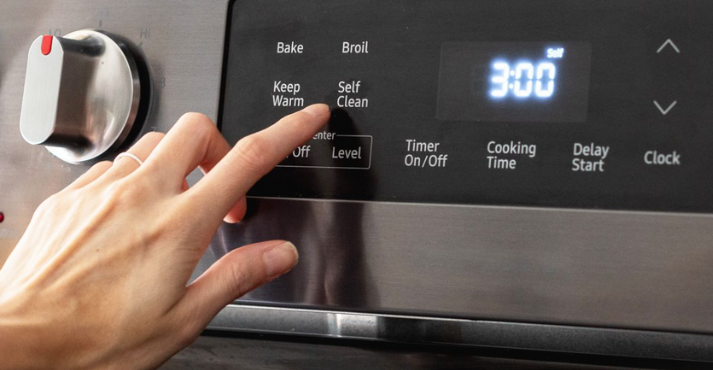
A self-clean oven is designed to burn off food residue and grease using extremely high temperatures, turning them into ash for easy cleanup. This method, known as pyrolytic cleaning, is more impactful than steam cleaning and requires minimal effort from the user.
How Does a Self-Clean Oven Work?
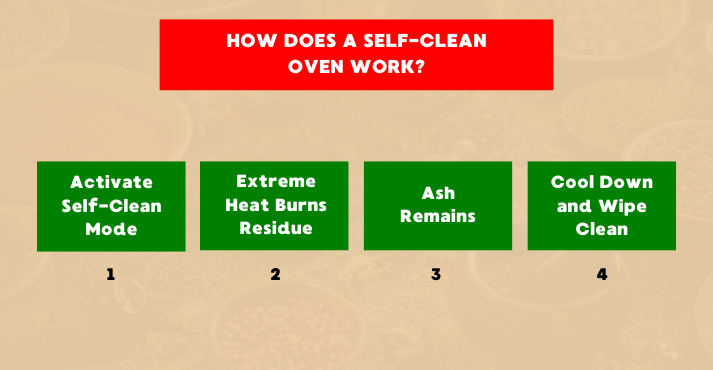
The self-cleaning function uses high heat to cremate stubborn grime and baked-on residue. This extensive process typically lasts between 2 to 4 hours. Here’s how the process works:
- Activate Self-Clean Mode – Select the self-clean function on the oven’s control panel. The oven will automatically lock for safety.
- Extreme Heat Burns Residue – The oven heats up to around 900°F (482°C), much higher than normal cooking temperatures, to burn and dissolve food particles and grease.
- Ash Remains – Once the cycle is complete, all residue is reduced to fine ash, thanks to the special enamel coating inside the oven that prevents buildup.
- Cool Down and Wipe Clean – The oven must fully cool down before unlocking. Once cooled, the remaining ash can be easily wiped away with a damp cloth.
Benefits of a Self-Clean Oven
The edge of deep cleaning makes this prolonged and extensive cleaning methodology a prominent pick when choosing between steam clean vs. self-clean ovens. This is what it means:
- It burns off even the toughest grime, grease, and food residue.
- It eliminates the need for harsh cleaning agents.
- Self-cleaning requires minimal effort, as heat does most of the work.
- It is ideal for deep cleaning, reducing the need for frequent manual scrubbing.
Things to Remember
However, self-cleaning ovens come with some considerations:
- Unlike steam cleaning, which is faster, the latter takes a few hours to complete.
- It uses significant electricity due to extreme heat.
- It can produce smoke and burnt smells, especially if there is a lot of grease buildup.
- The oven exterior can become very hot during cleaning, so proper ventilation is recommended after each cleaning cycle.
While self-cleaning is effective for deep cleaning, it should be used occasionally rather than as a routine cleaning method.
Tip: For best results, it’s advisable to wipe away major spills before running the self-clean cycle and ensure the kitchen is well-ventilated.
Steam-Clean vs. Self-Clean – Key Differences
[fusion_table fusion_table_type=”1″ fusion_table_rows=”” fusion_table_columns=”” margin_top=”” margin_right=”” margin_bottom=”” margin_left=”” hide_on_mobile=”small-visibility,medium-visibility,large-visibility” class=”” id=”” animation_type=”” animation_direction=”left” animation_speed=”0.3″ animation_offset=””]
| Feature | Steam-Clean Oven | Self-Clean Oven |
|---|---|---|
| Cleaning Duration | Takes between 30 minutes to 2 hours, depending on the grime level. | It requires 2 to 6 hours as it relies on extreme heat to burn residue. |
| Preparation Steps | Simply add a cup of water to the oven floor or a steam reservoir before starting the cycle. | Activate the self-cleaning function, and the oven automatically locks and begins the process. |
| Post-Cleaning Effort | It requires a thorough wipe-down after the cycle, and some scrubbing may be needed for stubborn stains. | It leaves only fine ash and requires a quick, gentle wipe once cooled. |
| Cleaning Process | Generates steam at low heat (around to soften food residues and grease for easier wiping. | It uses intense heat (up to 900°F/482°C) to incinerate debris into ash. |
| Safety Concerns | It operates at low temperatures (around 250°F or 120°C), making it safer with no excessive heat or smoke risk. | It reaches extreme temperatures, emits smoke, and requires proper ventilation; pets and children should be kept away. |
| Cost Factor | More affordable due to its more straightforward cleaning mechanism. | Higher cost due to features like automatic door locking and longer cycles. |
| Environmental Impact | It uses minimal energy and doesn’t release harmful fumes, making it more eco-friendly. | Due to high heat operation, it consumes more energy per cycle due to high heat usage but can be managed by adjusting the cleaning frequency. |
[/fusion_table]
Which Oven Cleaning Method is Best for Commercial Kitchens?
Choosing between steam clean vs. self-clean ovens in a commercial kitchen depends on efficiency, safety, and maintenance needs.
The rule of thumb is:
- Steam-clean ovens are the better daily cleaning solution for fast-paced commercial kitchens.
- Self-clean ovens can be helpful for occasional deep cleaning as they require more time and energy.
Combining both cleaning methods (Steam cleaning regularly and self-cleaning once or twice a month) can help maintain hygiene and efficiency without extended downtime in fast-paced commercial setups.
Let’s uncover this in more detail to help you find the best cleaning approach that suits individual requirements.
When to Choose a Steam-Clean Oven
A steam-clean oven is perfect if you want an easy-to-use, energy-efficient, and safe cleaning method.
A steam-clean oven is the best choice if you prefer a quick and low-maintenance cleaning method. With cycles lasting 30 minutes to 2 hours, it’s ideal for those who want to clean their oven frequently without consuming too much energy.
Since steam cleaning doesn’t produce toxic fumes or excessive heat, it’s safe to implement while working in the kitchen.
However, coupling this method with regular self-cleaning is required to prevent grease buildup, which may leave some moisture inside the oven and need proper ventilation.
When to Choose a Self-Clean Oven
Choose a self-clean oven if you want a powerful, chemical-free cleaning method and don’t mind the longer cleaning cycle.
A self-clean oven is best for those who need deep cleaning with minimal effort. A self-clean cycle can burn away grime effectively without scrubbing if you often cook greasy or messy dishes with stubborn residue.
Self-clean ovens are a good option for people who prefer less frequent but thorough cleaning. However, they use more energy, produce strong odors, and take up to 4 hours to complete.
Due to the high temperatures, extra caution is needed in domestic setups if you have children or pets (A safety lock feature also prevents accidental openings during the cleaning cycle).
Conclusion
Choosing between a steam clean vs. self-clean ovens oven depends on how often you clean, the level of buildup, and your kitchen environment. A steam-clean oven is ideal for frequent, low-energy cleaning with minimal heat and no fumes.
However, if you want deep cleaning with minimal manual effort, a self-clean oven is more effective but requires more time, energy, and ventilation.
Households with less usage can rely on the self-clean method for deep cleaning once a month. For commercial kitchens that can’t handle downtime caused by frequent self-cleaning, combining both methods (using steam cleaning for regular maintenance and self-cleaning for deep cleans) offers the most balanced approach.

